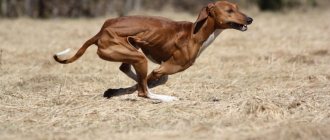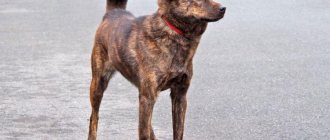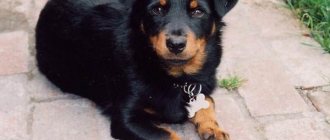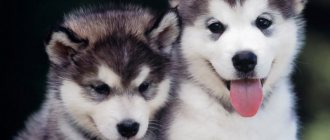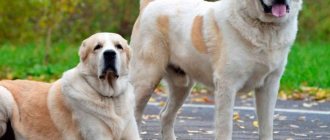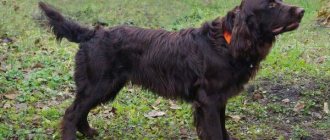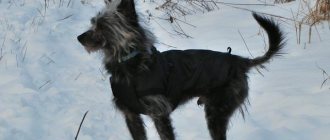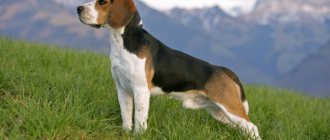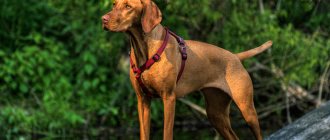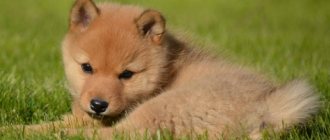| Origin | Russia (Yakutia) |
| Usage | sled and hunting dog |
| Color | white and any spotted |
| Dimensions | male height is 55-59 cm, female height is 53-57 cm, weight is 23-30 kg. |
| Lifespan | 10-12 years |
The Yakut Laika (YAL) is a special dog: self-sufficient, strong, smart. This is a devoted friend, completely human-oriented, but at the same time with the intuition of a wild animal. This is also the most unpretentious and hardy breed.
Origin story
Laikas of Yakutia are one of the most ancient. Their age is 8000 years. The first written description of the Yakut dog breed appeared in 1633.
Yakutia is a vast territory and the color of the dogs differed depending on the areas of residence: Ust-Maysky, Olekminsky, Suntarsky, Verkhne-Vilyuisky, Nyurbinsky. The peculiarity of the breed is that selection was carried out by nature: stupid, weak individuals simply did not survive. Laikas can not only live, but also work in such extreme conditions that other breeds simply cannot survive.
The origin of the Yakut Laika is associated with the Tunguska (Even). And it is believed that the breed was improved by crossing with wolves. Yakut Laikas are also known under other names: Tunguska, Chuvychan, Arctic, Polar, and Kolyma sled dogs.
The Yakuts did not ride in sleds. Mostly the Chukchi and Evens used sled dogs. Among the Yakuts, the animal was a hunter and also transported the caught fish. However, the breed was named because of its region of residence - Yakutia. Many admirers of the breed believe that the more correct name is “Yakut sled dog”.
Interesting facts about the breed:
- The first drawings depicting the Yakut Laika appeared in 1600.
- There is an assumption that Yakut dogs are the ancestors of the husky.
- Korean scientists made a clone from a piece of the ear of a Yakut husky.
- August 2021 – The American Kennel Club included the Yakut Laika in the list of rare pure breeds.
Yakut Sakha Yta and others
Just don’t associate the Yakut Laika with the aboriginal dog (sakha yta). The latter was used by local residents exclusively for hunting. The Yakuts valued tall animals (up to 70 cm), which easily moved through the snow in pursuit of foxes, ungulates, and sables.
Unfortunately, in the 70s. In the 20th century, the breed began to deteriorate, mixing with imported ones. Aboriginal Yakut hunting huskies were destroyed and purposefully, supposedly for the purpose of fighting infections.
Nowadays, aboriginal dogs are found only in remote settlements of the Lensky, Ust-Maisky and Olekminsky districts. And other breeds similar in type live in Evenkia and the Irkutsk region. Currently, active work is underway to restore the Yakut Hunting Laika (YaOL) or Sakha Yta breed.
The Chukotka sled dog, the Kamchatka sled dog, the Sakhalin sled dog, and the Yenisei sled dog are also separate groups of northern sled dogs. They have a lot in common with the Yakut sled dog, however, they are different.
History of the breed
The homeland of the Yakut Laika is Russia. In the north of this country, in the Yakut region, this breed appeared and developed. It belongs to the oldest species and is an unrivaled hunter.
The history of the Yakut Laika began over eight thousand years ago. This fact is confirmed by archaeological finds in the form of drawings, figurines and animal remains. In the harsh northern conditions, not every dog is able to survive and work.
The Yakut Laika has served humans since ancient times. She saved people's lives countless times, helped those who were lost find their way home, hunted game together with hunters, and protected homes from wild animals. This hardy dog was also used in sleds to transport goods. When snowmobiles had not yet been invented, this ability of huskies was highly valued.
Good health, unpretentiousness in maintenance, adaptability to low temperatures - the Yakut Laika acquired all this by living for centuries in the harsh Russian north.
There was a time when the breed was called the Kolyma Laika, and there was also a period when the purebred nature of these northern dogs was on the verge of degeneration. Let's trace the historical path of the Yakut Laika:
- Twentieth century 70s - breeders began to cross purebred Yakut Laikas with other types of dogs. Such experiments led to the almost complete disappearance of purebred representatives of the Yakut breed.
- The twentieth century - the 90s - the beginning of breeding purebred Yakut Laikas at the highest level.
- 2005 – Russia approved the standard for the Yakut Laika, which was officially recognized as a separate breed.
- 2008 – the first exhibition of Yakut Laikas was held.
- 2013 – official standard adopted.
Description of the standard
The Yakut Laika breed standard was approved in 2005. Before this, the breed was called the Kolyma Laika. The standard is registered in the RKF, but the Yakut Laika breed is not recognized by the FCI. According to the standard, YaL belongs to the group of sled and draft dogs. And today it is actively used in competitions. The breed is actively gaining popularity, since the Yakut has all the qualities for sledding.
The Yakut Laika is powerful, strong, hardy, unpretentious, and capable of working for a long time. Its thick coat allows it to survive in the harshest conditions of the north and withstand any frost.
Below is the standard of the Yakut Laika:
- The head is proportional to the size of the body. The shape resembles a pointed wedge. The forehead is high, the stop is well defined.
- The nose is black or brown. The breed standard excludes the absence of pigment on the nose and lips.
- The eyes are almond-shaped and not deep set. The color can be brown, blue or multi-colored (one brown, the other blue).
- The ears are triangle-shaped, thick and erect.
- The body is strong and muscular.
- Tail - forms a ring, thrown over the back.
- Limbs – both forelimbs and hind limbs are parallel and straight. Elbows point back and fit tightly to the body. The paws are well furred and large.
- The coat is thick with dense undercoat. Rough to the touch. There is a thick mane on the neck, especially in males, and feathering on the hind legs.
- Color – white with various variations: white-black, white-brown, white-gray. Another solid color is a sign of disqualification.
Characteristics of the breed exclude: short legs, barrel-shaped chest, sluggish movements, wavy, soft coat.
Description of the Yakut Laika
The Yakut Laika is one of the most beautiful and charming dogs in its group. The cheerful disposition and positive appearance have made the rare northern breed fashionable and in demand in a new role - as a companion. But such a role is not suitable for every Yakut: these active dogs are used to working hard.
Appearance
The exterior of the Yakut Laika is regulated by the RKF standard, the latest amendments to which were made in 2015. The breed belongs to the fifth group (“Spitz and primitive breeds”), to the first section (“Northern sled dogs”).
The Yakut Laika attracts attention both at work and at the exhibition
Table: exterior of the Yakut Laika according to the RKF standard
| Main articles | Description |
| Dimensions | optimal height at the withers is 56 cm for a male, 55 cm for a female; average weight - for a male 30 kg, for a female 23 kg; Males are noticeably more powerful and stronger than females. |
| Addition |
|
| Head |
|
| Limbs |
|
| Tail |
|
| Wool |
|
| Colors |
|
Laikas run through the snow easily and do not fall into it
The Yakut Laika moves quickly, easily and elastically, does not fall into the snow and does not slide on the ice. Typical gaits for her are gallop and energetic trot.
Character and behavior
Most Yakut Laikas are still used to this day in the harsh northern climate as working dogs: sled dogs or hunting dogs. The work shaped their character - strong, decisive, independent. Yakuts make excellent guards: they are very intuitive, accurately guess the bad intentions of a stranger and know what to do about it. By the way, despite their breed name, huskies only bark for business.
The Yakut Laika's lifestyle is built around work
They are devoted to their owner and his family; for children they can become not only a vigilant protector, but also an attentive nanny. If there is no danger or any extreme situations, the Yakuts remain calm and friendly. People are treated with respect, understanding and patience.
The Yakut Laika, especially the bitch, can be left alone with a small child without fear: she will be vigilant and caring
Having other dogs in the house is absolutely not a problem - the husky will get along well with them. With other domestic animals, situations can develop differently. Laika will not touch a cat or even a hamster, with whom she grew up, but she will most likely perceive the same animals “on the side” as game and will enthusiastically begin to hunt them.
Yakuts find a common language with any dogs
Disqualities and disadvantages
Experts evaluate the defects of the Yakut Laika in relation to the working qualities of the dog - that is, to what extent certain breed defects can affect the performance of traditional functions, as well as the health of the animal. Thus, any of the following vices can serve as a reason for disqualifying a Yakut:
- aggressiveness or cowardice;
- disproportionality of addition;
- males in bitch type;
- undershot, undershot with waste, jaw misalignment;
- complete depigmentation of the nose, eyelids and lips;
- any solid color except white;
- smooth coat.
This short-haired husky is a breed defect, although everything is fine with her working qualities
Character
Yakut Laikas are smart, patient and caring. They are distinguished by absolute devotion to their owner. Laika is human-friendly, calm, and really loves to bark.
The main thing in education is rigor and consistency. These are aboriginal dogs and obey only a strong leader. They constantly strive to contact people. Yakuts respond best to training based on a friendly attitude and reinforced with treats. Then the dog works willingly and is easy to work with.
Dogs have excellent vision, hearing and sense of smell. They are distinguished by a sharp mind and flexible character. YaL has independent thinking and will only listen to the person he completely trusts.
Where can I buy
The best place to purchase a Yakut Laika is considered to be specialized nurseries. Here you will be consulted in detail, recommending a dog with the best set of qualities for your specific needs. By purchasing a companion for hunting, hiking, living outdoors or in a city apartment, you will get an animal that quickly adapts to certain conditions and will become your reliable friend. Yakut Laika puppies, upon reaching the age of 8-10 weeks, are already quite ready to start life with a new owner. The main advantage of buying a Yakut Laika from a nursery is the presence of all accompanying documents - vaccination certificates, pedigree statements, passports. You can be sure of the absolute physical and mental health of your pet, which is confirmed. When buying this breed secondhand on the market, you run the risk of purchasing a non-purebred individual with diseases.
Before contacting a nursery or an official breeder, carefully study the reviews and visit the place in person to form your own opinion. If you decide to get a calm, friendly and loyal four-legged friend, don’t hesitate to buy a Yakut Laika. She will become your excellent companion, protector and partner. In order for the animal to be healthy and happy, do not forget to provide the dog with proper physical activity, devoting sufficient time to communicate with the pet.
Application
For centuries, the Yakut Laika has been an assistant to the family and its full member.
And now the breed has not lost its versatility:
- These are sled dogs. They are smart, obedient, hardy. They are not afraid of frost.
- YAL - hunters. They can be trained for any animal: fur-bearing, ungulate. They are not afraid of bears and moose.
Due to their friendly nature, Laika guards are bad. They can only warn the owner by barking, but will not attack uninvited guests. Moreover, aggressiveness is considered a disadvantage of the breed.
Yakut huskies are easy to train and run in harnesses. Freestyle, frisbee, general course - they master everything quickly. After 9 months, you need to get used to physical activity. The main thing in education is firmness. Cruelty is prohibited. From such an attitude, the dog loses its qualities, becomes angry and disobedient.
Origin of the breed
The breed was bred in the 17th century, the homeland of huskies: Nizhnekolymsk region of Yakutia, beyond the Arctic Circle. Translated from the local dialect, the name is translated as “Yakut dog”. The first researchers: Yokhelson (19th century), Vladimir Dyachkov, German Arbugaev (1998). The standard was officially approved in 2005 by the Russian Canine Organization. The first purpose of dogs is deer hunting, then sled riding. With an active lifestyle, he is fed every day, during rest - 1 r every 2 days, in order to avoid gaining excess weight.
How to choose a puppy
Yakut Laika puppies already from birth have skills that are passed on genetically. Breeders note that young animals that have not yet been trained in anything, but harnessed to a harness, begin to pull it.
The puppy is taken from the nursery at 8, preferably 10 weeks. During this time, the breeder will accustom him to proper nutrition, and the puppy will learn a lot from his mother and his littermates. It has been noted that puppies that are adopted too early can be nervous and have difficulty toilet training.
The future owner decides whether to choose a dog or a bitch. Bitches are hardworking, attached to their owner, neat, obedient, and learn faster. They are smarter than males and are not prone to wandering. Yakut males are stronger, tougher and more courageous. If it is intended to use a YAL as a hunter, preference is given to a male.
Some recommendations for choosing a puppy:
- It is better to choose a medium-sized kitten from a litter, but well-fed.
- He should have clean, pus-free eyes, a curled tail and erect ears.
- It is advisable to take a puppy from young parents (from 2 to 7 years old). The droppings from old animals are usually physically weak.
- There is no need to be shy about asking for documents for your parents. It is important to ensure that they have the work credentials, which is usually confirmed by field diplomas.
You can also take an adult dog from the kennel. Yakuts quickly get used to their new owner.
Dossier
Adult height: 53-59 cm (optimal: male 55 cm, female 54 cm). Weight: about 21-23 kg. Characteristic color: black and white, white and black, black and white with red spots, gray and white, white and gray, white and red, red and white, white (any solid color other than white is considered a breed defect). Coat length: thick coat, with a strong undercoat, length up to 10 cm. Life expectancy: 10-14 years. Advantages of the breed: high resistance to frost, sociability, non-aggressiveness. Difficulties of the breed: poor heat tolerance, tendency to certain diseases (joint dysplasia, eye diseases, stomach cancer). Average price: $350-550 (depending on genealogy). Classification: large breed; sledding, hunting.
Features of maintenance and care
Yakut Laikas are sled dogs with a highly developed hunting instinct. Therefore, they need constant training and exercise. Playing in the yard, sledding, running with a bicycle - these are their favorite activities. YALs are suitable for energetic people who have time and want to spend it on their pet.
YAL puppies are very energetic and active. For the first 2-3 months (minimum), they are kept at home so that they have more contact with humans and undergo primary training.
The Yakut Laika is not suitable for apartment living. In addition, representatives of the breed are big fans of barking. YAL should live on the street. The best place to keep it is a private house, where you can organize an enclosure and set up a booth.
If you keep your dog on a chain all the time and occasionally take it out, for example, into the forest, he will have a weak back and paws. Such animals do not obey their owner well as soon as they break free. They begin to accept commands when they have had enough exercise and are tired. Chained huskies are often vicious and have a hoarse voice.
For a dog to grow up smart, loyal, and loving to its owner, it needs to be raised in freedom, fed well, trained, constantly in contact with it, played and communicated.
Grooming
The Yakut Laika has long hair (hair length is approximately 10 cm) and a very thick undercoat. This allows her to feel great at -50 -60 degrees and endure a long winter. The undercoat is so thick that it does not release its own body heat, so the animals do not freeze. This is also related to energy exchange. If other breeds get 30% of nutrients from food, then the sled husky gets 70%. In Yakutia, dogs are kept in open-air enclosures and sleep right in the snow.
The Yakut Laika, like all dogs, needs to be brushed. It is held once a week. During the molting period, to speed up and facilitate this process, comb your pet daily.
Yakuts don't need a haircut. It is enough to trim the fur between your toes so that debris does not get stuck in it, which can cause irritation.
They bathe the husky 2-3 times a year. Its fur has the ability to self-clean and does not smell like a dog.
Claws are trimmed once every 2-3 weeks. Ears are cleaned weekly. Your pet needs to be taught this from puppyhood.
Walk
The Yakut Laika dog is for active people. She needs both physical and mental stress. She easily adapts to her owner's life, its rhythm and style. Without an active life, a pet can get sick and die.
Laika is not a working breed and is very independent. So that she does not lose this quality, she should not be overloaded with commands during training, this spoils the dog.
Feeding
Among the owners of YL there are adherents of natural nutrition and dry food.
With a natural diet of meat products, you can give:
- Meat, ears, tripe, liver, heart, kidneys.
- Squid, sea fish - once a week instead of meat products.
- Cereals: buckwheat, rice, millet, oatmeal and chaff (waste from grinding). Peas and barley are not allowed. Cereals need to be changed or combined 2-3 at a time.
- Any vegetables.
- Fermented milk products: cottage cheese, kefir. They also give you cheese.
- Eggs are added 2-3 times a week raw.
The Yakuts feed their dogs what they eat themselves. And these are mainly seafood products. Fish and meat of sea animals are given both raw and fermented. These products have no equal in terms of nutritional value.
When kept in cities, animals are often transferred to industrial feed. In this case, you need to choose food with a reduced carbohydrate content and a high level of protein.
Character and temperament
The main feature of the Yakut Laika is its immense devotion to its owner, friendliness and excessive efficiency. These animals love all members of their family very much, however, for them there is always the most important one - the “leader”. As a rule, this is the head of the family. It is his commands that are carried out unconditionally; the pet may sometimes not hear or ignore others.
Yakut will never become a good guard, since his attention is very easy to redirect in another direction. And this is not surprising, because huskies have never been watchdogs; they are ideal hunters and sled dogs.
They behave well with children, they enjoy playing outdoor games with them, take part in pranks and never offend them, even if the child inadvertently causes pain. The Yakuts patiently and steadfastly endure all the hardships and periods of growing up of children.
Aggression is extremely low and can only appear during the hunt or when someone close to you is in real danger. They treat strangers with suspicion, but without excessive anger or signs of aggression.
It is important to note that Yakuts are dominant, so you need to immediately identify yourself and let your pet know who is boss in the house.
Health
The Yakut Laika is a healthy and hardy breed. However, like all other dogs, she can have health problems. The animal needs to be examined regularly: look at the gums, check the elasticity of the skin, check for signs of diarrhea, examine the limbs and spine, especially if the dog is used as a sled dog.
Diseases
To keep the animal in shape, you need to monitor the condition of the hip and elbow joints; Yakuts may also have bloating and eye problems.
Vaccinations
Yakuts are no exception and they also need to get all vaccinations.
Mandatory vaccinations against rabies and canine distemper. Also, after consultation with a veterinarian, vaccinations against the following diseases are given:
- Parvovirus enteritis;
- Parainfluenza;
- Leptospirosis;
- Coronavirus.
Piroplasmosis and Lyme disease in dogs are infectious diseases transmitted by infected Ixodid ticks. Therefore, in the autumn-spring period, animals must be vaccinated against them. Now there are complex vaccines against several diseases at once. For example, the vaccine from the Nobivak company.
All vaccinations are given according to the schedule:
- For the first time, Yakut Laika puppies are vaccinated at 1.5-2 months.
- Repeated vaccination after 2 weeks.
- The third after changing teeth (at about 6-7 months).
- The fourth one in a year. Approximately when the dog is 1.5 years old.
- Then every year for the rest of your life.
Before each vaccination, the puppy is dewormed 10-14 days before. Without this procedure, the vaccination will be ineffective.
Frequent illnesses and problems
Since the breed was bred almost naturally, the representatives are distinguished by good health. It is important to adhere to a diet and care regimen: a lack of microelements leads to bone deformation in childhood. Laikas are prone to the following diseases:
- eczema, dermatitis;
- oncology;
- gastrointestinal disorders;
- hip dysplasia;
- retinal atrophy;
- glaucoma;
- cataract;
- inflammation of the third eyelid.
If the pet is hot, skin problems appear; in old age, deformation of the joint pocket in the paws and the head of the bone is possible.
The Yakut Laika is distinguished by its calm and friendly disposition. It is easy to train; there is no need to use the whip method - the dog understands all commands, thanks to its developed intelligence. This is a loyal friend and an excellent hunter who loves long walks in the fresh air. Does not tolerate heat, it is difficult to take root in apartments. Space and cold are two of this breed’s favorite things.
Siberian Husky is the hardiest dog breed
While greyhounds are the fastest dogs, huskies are the toughest. A husky team can travel more than 160 km per day, moving at a speed of more than 17 km/
The homeland of the French poodle is not France.
The homeland of the poodle is Germany. The name "poodle" is derived from the German "pudel" or "pudelhund" and means "splashing dog." The world-famous haircut of poodles appeared when hunters cut their hair for ease of swimming, leaving only a little fur to keep warm.
Dogs' paws sweat
It turns out that dogs sweat too. But while humans sweat through the skin all over their bodies, dogs sweat through their paws. You can verify this by watching your dog on a hot summer day. A characteristic symptom will be a salty odor, reminiscent of popcorn or corn chips.
Walks
An apartment husky needs a very active walk ... the dog should run at least 2-3 hours a day (excluding training). The four-legged dog needs to be taken out of town or walked in deserted places at least 3-4 times a week. Be careful and make sure that your pet does not go near natural dumps; there may be rats in the garbage, which the four-legged animal will not be too lazy to catch.
Related breeds
Finnish Spitz (Karelo-Finnish Spitz, Karelian-Finnish Laika)
The Finnish Spitz (or as it is also called - the Karelian-Finnish Spitz or the Karelian-Finnish Laika) is a friendly, inquisitive and cheerful pet. Outwardly, he is similar to a fox, as can be seen from numerous photos. In addition, he is a good hunter. For his many positive qualities, he found the love of many dog breeders. The price of a Finnish Spitz, appearance and character traits - these are the questions that interest potential breeders.
The Finnish Spitz is a wonderful friend, hunter, watchman and protector. This is a universal dog that will delight you with its cheerful character and unusual appearance. The Finnish Spitz is a breed for active and energetic people.
Caring for Yakut huskies and keeping dogs
The Yakut Laika feels great in cold climates, but is uncomfortable in hot climates. Therefore, a husky should not live in an apartment; even in severe frosts, it will be better off in an open enclosure than in a warm apartment.
If this dog's hunting instincts are not satisfied, he may feel unfulfilled and therefore become restless.
Otherwise, caring for these animals is no different from caring for other hunting dogs.
For prevention and care, the owner needs:
- Treat your dog for fleas and ticks every 4 months, regardless of the season and living conditions.
- Carry out worm prevention every 3 months.
- Feel and examine your pet once a day.
- Clean your eyelids if necessary.
- Wipe your ears if gray (dusty coating) appears.
- In case of direct bite or overbite, preventive teeth cleaning and feeding of hygienic treats are required.
- Trim nails as needed and monitor their length, even when kept outside.
- If necessary, shorten the hair growing between the fingers.
- In summer, Yakut huskies have a hard time, but their white color partially saves them. No matter how good your pet may look, it is natural for him to have sub-zero temperatures, so in the heat you need to take all measures to prevent heat stroke. Move your walk to early morning or late evening, provide your dog with plenty of fluids and the opportunity to rest most of the day. Dogs with large black spots will find it much easier to survive the midday heat in a wet, white, cotton T-shirt
Never leave Laika (or any other dog) locked in a car in spring, autumn and especially in summer.
Nutrition
The Yakut Laika is not fussy about food. The amount of food is much less than that required for feeding other hunting dogs.
Your dog's diet should include:
- boiled beef meat;
- millet, rice and oatmeal porridges;
- boiled sea fish;
- fresh vegetables (preferably chopped carrots and dried fruits).
It is necessary to add vitamins and minerals to the food that are necessary for the growth and development of dogs. Feeding is done in the morning and evening.
To prevent the development of dental diseases, huskies are given bones to chew on.
Clean water should always be near the animal's booth. It should be changed at least twice a day.
You should not treat your dog with sweet confectionery, smoked meats or add seasonings to food; it is also not advisable to feed you fermented milk products.
All this can lead to various gastrointestinal disorders and have a negative impact on health.
It is not recommended to give dry food to your animal.
They can be used in exceptional cases as a reward for following a command during training.
Twice a month it is necessary to triple fasting days, during which the dog receives only water and crackers as food. This procedure is necessary to cleanse the body.
